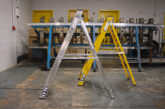
Steve Boggis, Trade Business Unit Director for FireAngel, discusses how electrical contractors can ensure residential properties are adequately protected against CO and the technologies they should be installing to achieve the highest standards of safety.
It’s estimated there are around 60 deaths due to accidental carbon monoxide (CO) poisoning throughout England and Wales each year, as the winter season quickly approaches and individuals increase their use of solid fuel burning appliances,
Alarms provide the only method of detecting the presence of CO, due to the poisonous gas being tasteless, odourless and colourless.
However, in 2018, the English Housing Survey evidenced only 42% of dwellings had a CO alarm, with owner-occupied and social rented homes more likely to have a CO alarm installed than private rental sector dwellings.
Due to the impact of COVID-19, the installation of a CO alarm throughout all types of residential properties is more important than ever, as many individuals delayed the annual servicing of their appliances, including boilers.
There are some key considerations that professionals should therefore address when recommending and installing CO alarms throughout residential properties this winter season:
Placement
In accordance with European Standard EN 50292, CO alarms should be fitted in the same room as fuel-burning appliances, such as an open fire, gas cooker or boiler, and can be either wall or ceiling mounted.
It is advised that additional alarms should be located in bedrooms relatively close to the breathing zone of the occupants, whilst alarms should also be installed in any room where there is a flue running through it.
For ceiling mounted installations, the alarms should be at least 300mm away from any wall. For wall mounted alarms, they should be at least 150mm from the ceiling and above the height of any door or window.
For both types of installations, the alarms should be between one and three metres away from the potential source of CO, to ensure the highest standards of detection.
CO alarms shouldn’t be installed within enclosed spaces, directly above sinks or next to a source of ventilation, such as a door, window, extractor fan or air vent. It is also important to ensure the alarm isn’t installed in a location where the temperature may exceed 40degC or drop below -10degC.
Certification
Some online resellers may supply devices that only display the CE mark but installers should always ensure that CO alarms are approved to European standard EN 50291-1 and carry a third party approval mark, such as the BSI Kitemark, to demonstrate independent testing and certification to the standard.
Regulations
CO regulations currently vary throughout the UK, with the main legislation applying to England and Wales included throughout the Smoke And Carbon Monoxide Alarm (England) Regulations 2015 and Building Regulations Document J.
These regulations require CO alarms to be fitted when any new or replacement solid fuel burning appliance is installed, in addition to all rooms where there is a solid fuel burning appliance throughout private residential properties.
The alarm must be either mains-powered or battery powered, with the battery designed to operate for the working life of the alarm. Both power types should also feature a warning device to alert users when the working life of the alarm is due to pass, or in the event of a sensor failure warning.
The latest government consultation: Domestic Smoke and Carbon Monoxide Alarms: Proposals to extend regulations, is calling for amendments to be made to the statutory guidance (Approved Document J), which supports Part J of the Building Regulations, requiring CO alarms to be fitted alongside the installation of fixed combustion appliances of any fuel type, excluding gas cookers.
It is also requesting the amendment of the Smoke and Carbon Monoxide Alarm (England) Regulations 2015, requiring private and social landlords to install a CO alarm in any room used as living accommodation where a fixed combustion appliance is used. The requirement for landlords to ensure appropriate checks are made to ensure each prescribed alarm is in proper working order is also proposed. Interlinked technologies
Interlinked technologies
FireAngel’s Specification Range FS1326-T Wireless Interlink Carbon Monoxide Alarm meets current regulations. It features a 10-year sealed for life lithium battery, combined with advanced electrochemical sensors and intelligence diagnostics.
Smart RF Ready for enhanced protection, the device can be wirelessly interlinked with additional FireAngel Smart RF enabled smoke and heat alarms to form a private network. This means when one alarm sounds, they all sound, providing the earliest possible warning of the presence of CO, in addition to fire.
To create a wireless interlinked network, simply fit a Smart RF Radio module into the alarm, either upon initial installation, or at a later date, and interlink multiple smoke, heat and CO alarms together onto a hybrid network.
TO GET MORE DETAILS ON THE FIREANGEL SPECIFICATION RANGE CLICK HERE









